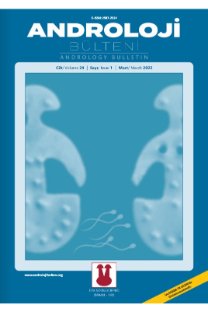Penil fraktür ve neden olduğu üretral yaralanmaya yaklaşımımız; 10 yıllık cerrahi deneyim
Our approach to the penile fracture and urethral injury caused; ten years of surgical experience
___
- 1. Zargooshi J. Sexual function and tunica albuginea wound healing following penile fracture: An 18-year follow-up study of 352 patients from Kermanshah, Iran. J Sex Med 2009;6:1141–50. doi: 10.1111/j.1743-6109.2008.01117.x
- 2. Al-Shaiji TF, Amann J, Brock GB. Fractured penis: Diagnosis and management. J Sex Med 2009;6:3231–40. doi: 10.1111/j.1743- 6109.2009.01593.x
- 3. Koifman L, Barros R, Júnior RA, Cavalcanti AG, Favorito LA. Penile fracture: Diagnosis, treatment and outcomes of 150 patients. Urology 2010;76:1488–92. doi: 10.1016/j.urology.2010.05.043
- 4. Acikgoz A, Gokce E, Asci R, Buyukalpelli R, Yilmaz AF, Sarikaya S. Relationship between penile fracture and Peyronie’s disease: A prospective study. Int J Impot Res 2011;23:165–72. doi: 10.1038/
- 5. Majzoub AA, Canguven O, Raidh TA. Alteration in the etiology of penile fracture in the Middle East and Central Asia regions in the last decade; a literature review. Urol Ann 2015;7:284–8. doi: 10.4103/0974-7796.157973
- 6. McAninch JW, Santucci RA. Genitourinary trauma. In: Walsh PC, Retik AB, Vaughan ED, Wein AJ, eds. Campbell’s Urology 8th edition, Vol 4, Chapter 105. Philadelphia, PA. WB Saunders; 2002. p.3707–44.
- 7. Tsang T, Demby AM. Penile fracture with urethral injury. J Urol 1992;147:466–8.
- 8. Maubon AJ, Roux JO, Faix A, et al. Penile fracture: MRI demonstration of a urethral tear associated with a rupture of the corpus cavernosum. Eur Radiol 1998;8:469–70. doi: 10.1007/ s003300050416
- 9. Yapanoglu T, Aksoy Y, Adanur S, Kabadayi B, Ozturk G, Ozbey I. Seventeen years’ experience of penile fracture: Conservative vs. surgical treatment. J Sex Med 2009;6:2058–63. doi: 10.1111/j.1743-6109.2009.01296.x
- 10. Zargooshi J. Sexual function and tunica albuginea wound healing following penile fracture: An 18-year follow-up study of 352 patients from Kermanshah, Iran. J Sex Med 2009;6:1141–50. doi: 10.1111/j.1743-6109.2008.01117.x
- 11. Fetter TR, Gartman E. Traumatic rupture of penis. Case report. Am J Surg 1936;32:371–2.
- 12. Lynch TH, Martínez-Piñeiro L, Plas E, Serafetinides E, Türkeri L, Santucci RA, et al. EAU guidelines on urological trauma. Eur Urol 2005;47:1–15. doi: 10.1016/j.eururo.2004.07.028
- 13. Malis J, Zur K. Der fractura penis. Arch Klin Chir 1924;129:651.
- 14. Agarwal MM, Singh SK, Sharma DK, Ranjan P, Kumar S, Chandramohan V, et al. Fracture of the penis: a radiological or clinical diagnosis? A case series and literature review. Can J Urol 2009;16:4568–75.
- 15. Jack GS, Garraway I, Reznichek R, Rajfer J. Current treatment options for penile fractures. Rev Urol 2004;6:114–20.
- 16. Muentener M, Suter S, Hauri D, Sulser T. Long-term experience with surgical and conservative treatment of penile fracture. J Urol 2004;172:576–9. doi: 10.1097/01.ju.0000131594.99785.1c
- 17. Gamal WM, Osman MM, Hammady A, Aldahshoury MZ, Hussein MM, Saleem M. Penile fracture: long-term results of surgical and conservative management. J Trauma 2011;71:491–3.
- 18. Mydlo JH. Surgeon experience with penile fracture. J Urol 2001;166:526–8.
- 19. Mahapatra RS, Kundu AK, Pal DK. Penile Fracture: Our Experience in a Tertiary Care Hospital. World J Mens Health 2015;33:95–102.
- 20. Karadeniz T, Topsakal M, Ariman A, Erton H, Basak D. Penile fracture: differential diagnosis, management and outcome. Br J Urol 1996;77:279–81.
- 21. el-Sherif AE, Dauleh M, Allowneh N, Vijayan P. Management of fracture of the penis in Qatar. Br J Urol 1991;68:622–5.
- 22. Penson DF, Seftel AD, Krane RJ, Frohrib D, Goldstein I. The hemodynamic pathophysiology of impotence following blunt trauma to the erect penis. J Urol 1992;148:1171–80.
- 23. Nane I, Tefekli A, Armagan A, Sanli O, Kadioglu A. Penile vascular abnormalities observed long-term after surgical repair of penile fractures. Int J Urol 2004;11:316–20. doi: 10.1111/j.1442- 2042.2004.00794.x
- 24. Phillips EA, Esposito AJ, Munarriz R. Acute penile trauma and associated morbidity: 9-year experience at a tertiary care center. Andrology 2015;3:632–6. doi: 10.1111/andr.12043
- 25. Ahmadnia H, Younesi Rostami M, Kamalati A, Imani MM. Penile fracture and its treatment: is retrograde urethrograghy necessary for management of penile fracture? Chin J Traumatol 2014;17:338– 40.
- 26. Kiliçarslan H, Gökçe G, Kaya K, Ayan S, Gültekin YE. Surgical treatment of penil fractures. Ulus Travma Acil Cerrahi Derg 2003;9:54–6.
- 27. Ugwu BT. Penile fracture in a developing environment. J West Afr Coll Surg 2014;4:x-xi.
- 28. Koifman L, Cavalcanti AG, Manes CH, R Filho D, Favorito LA. Penile fracture: experience in 56 cases. Int Braz J Urol 2003;29:35– 9
- ISSN: 2587-2524
- Yayın Aralığı: Yılda 4 Sayı
- Başlangıç: 1999
- Yayıncı: Turgay Arık
Kadmiyumun erkek üreme sistemi üzerine etkisi
Penil fraktür ve neden olduğu üretral yaralanmaya yaklaşımımız; 10 yıllık cerrahi deneyim
ÖZKAN ONUK, Nusret Can ÇİLESİZ, Arif ÖZKAN, Aydın İsmet HAZAR, Burak ARSLAN, Cem Tuğrul GEZMİŞ, Memduh AYDIN
Kistik fibrozis transmembran regülatör (CFTR) genindeki M470V polimorfizmi ve erkek infertilitesi
Ebelik öğrencilerinin kendi kendine meme muayenesi ile ilgili bilgi ve tutumlarının belirlenmesi
SAADET GONCA MAVİ AYDOĞDU, ZELİHA KARAPELİT
Ahmet Gökçe başta OLMAK, Mustafa Faruk USTA
Kanserli hastalarda cinsellik nasıl değerlendirilmeli?
Fiziksel ve kimyasal etkenlere maruziyet doğumlardaki cinsiyet oranını etkileyebilir mi?
APSSM MEETİNG, ISSWSH Fall COURSE, San FERNANDO, Basic Semen Analysis COURSE, Lars BJÖRNDAHL
